Probably the first weapons used by man (besides fists) were sticks and stones. These were useful for scaring off or hunting wild animals, and in defense against attacks by other men. Soon these basic weapons were “improved” by sharpening and shaping so that stones became spearheads, sticks were used as heavy clubs, and tusks and horns were shaped into knives or daggers. With the advent of the bow and arrow, weapons could finally be used from a distance. Man is a very inventive beast, and so, as various materials were discovered, he seems to have spent a lot of time and effort–not to mention money–on the creation of bigger, better, more efficient, and far more deadly weaponry.
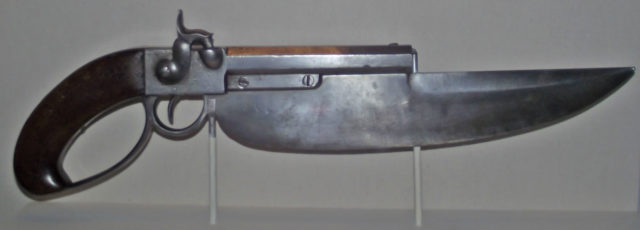
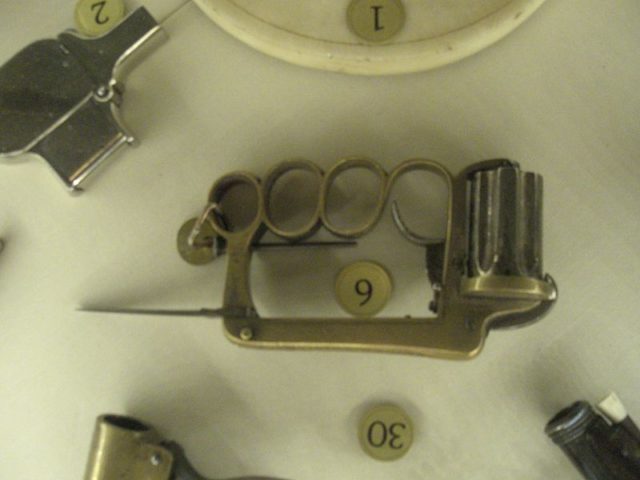
The very first record we have of firearms came as the properties of gunpowder were discovered and evidence of the existence of it appeared on a 10thcentury Chinese tapestry. This showed a simplistic hand-held cannon, with a powder-filled tube affixed onto a lance, that was used much like a flamethrower. Further records tell of these fire-lances being used effectively during a siege in 1132. Following improvements such as metal for barrels, high-nitrate powders, and better projectile propellant features, the gun was born.
A very early depiction of a gun, dating to the 12th century, is in the form of a sculpture found in a cave in China that shows a figure carrying a firearm. Also located in China is the oldest-known surviving firearm, dating back to 1288.
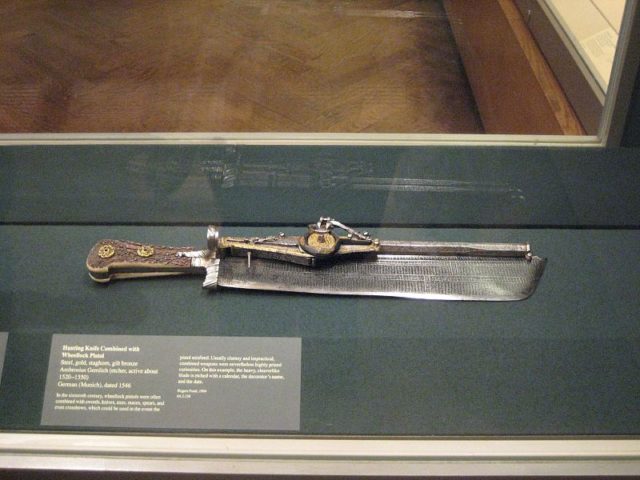
The development and use of firearms, so the theory goes, traveled to Europe via the Silk Road during the 13th century. From hand-held, hand-ignited canons, the ignition mechanism evolved into matchlocks which, in turn, were improved by the use of wheel locks. Then progress was made to flintlocks and, finally, to the percussion cap. These improvements allowed the development of the flintlock rifle, the breech loader, and the automatic.

As the development of guns and gun-making progressed through the centuries, many different ideas and inventions came to light, creating a variety of weapons of interest to both the gun collector and the historian. Some of the most interesting were combination weapons. Since earlier guns, once fired, required time for reloading, there was the risk of being attacked with no means of defense, so the combination weapon was designed to solve this problem. These weapons, (unlike the bayonet, which was attached to the firearm), had their primary design and use as an ax, sword, knife, or dagger; the pistol was attached to this primary weapon.
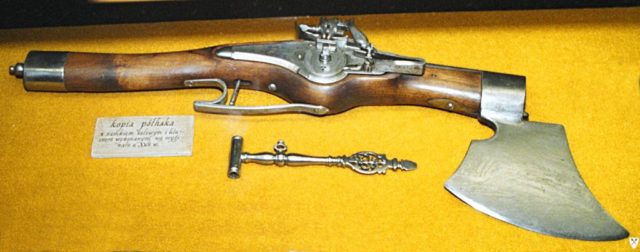
CC BY-SA 3.0
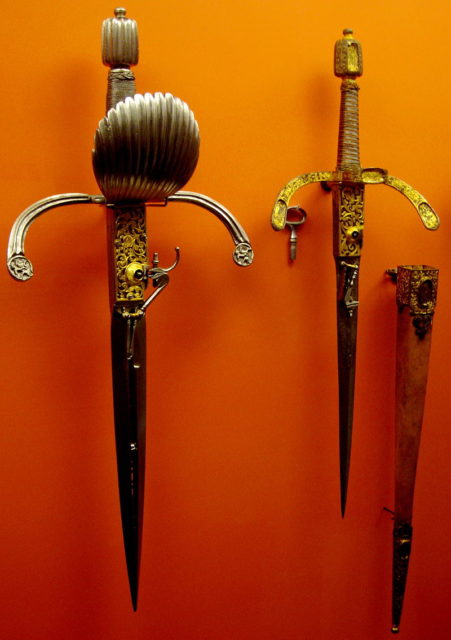

Pistol axes were first used in Europe towards the end of the 15th century and remained in use until well into the 1800s. The ax was the easiest weapon to combine with the pistol. Germans used a pistol ax with a wheel-lock firing mechanism; it had a six-inch barrel that fired out of the head of the ax. The pistol ax was used primarily by horseback riders. Matchlock and flintlock pistol axes were also made, and the Polish cavalry was known for predominantly using flintlock axes during the 16th, 17th, and 18th centuries.
During the 17th and 18th centuries, flintlock pistols were popularly used for gun-swords, with the barrel of the pistol being fastened along the side of the short-sword blade or the dagger blade. Pistol swords and pistol knives were used mostly by French and German hunters to kill wounded wild boar; they were a backup for their rifles. The combination of a firearm and a dagger was more common than a firearm and a sword, for it was smaller, easier to manipulate, and did not unbalance the weapon as with the sword. It was less expensive, as well. Pistol swords were thus generally purchased by the aristocracy and the wealthy and were often decorated. India made similar weapons, one of which was the Katar, a thrusting dagger that housed two built-in pistols that were fired by squeezing the handgrip bars together.

Cutlass pistols were very popular during the age of piracy in the 1500s. Pirates would use a flintlock pistol attached to the side of a cutlass for boarding purposes. The pistol would be discharged before engaging in hand-to-hand sword fighting. The advantage of this particular weapon was that both weapons (firearm and cutlass) were held in one hand and together were at the ready, leaving one hand free.
The Elgin Cutlass Pistol was developed by the U.S. Navy in 1838. This was a .54 caliber, single-shot, smoothbore pistol attached to an 11.5-inch Bowie knife blade. It was the first percussion cap gun used by the Navy, and only 150 were made. It was intended for use by boarding parties, specifically for a South Seas expedition. It was reported to be greatly effective when the sailors were attacked by warriors on an island. Some of these pistols were used during the US Civil War, but they were not popular–possibly because with the blade, the gun was 17 inches long and rather unwieldy. It was also expensive to produce.
In 1865, 500 Swedish cutlass pistols were ordered by the American Government and issued to prison guards. These pistols were breech-loading, 2-shot weapons with a 14-inch blade. It is reported that Buffalo Bill had one of these pistols in his gun collection.
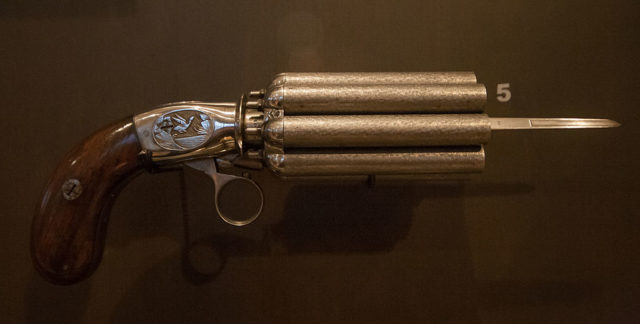
During the late 1800s, Belgian and French pepperbox revolvers, coupled with a knuckle duster and a wavy blade, became popular. The addition of a pinfire cartridge, one of the very first successful metallic, self-contained cartridges invented by Frenchman Casimir Lefaucheux, enhanced its usefulness. The Pepperbox Pinfire was a small revolver designed for self-defense. These revolvers were made so that the trigger, as well as the blade and the knuckle dusters, could fold up, making the weapon streamlined and easily concealed or carried in the pocket. It found much use in the Paris underworld.
Pinfire cartridge gun-swords were produced in Belgium during the mid-19th century, in limited quantities and mostly for the use of European officers. A Solingen gunsmith filed a patent on the design of a pistol sword which had a 32-inch blade and a 9mm caliber pistol.

The British also designed a type of dagger-pistol, in the form of a Webley revolver that sported a folding blade, for use during World War I. The design was similar to that of the Pritchard pistol that carried a bayonet blade. The intention was to issue the Webley pistols to officers for close quarters fighting in the trenches, where the use of a sword would be impossible in the confined space. But very few were manufactured due to the cost and the scarcity of raw materials during the war years.
Read another story from us: Goose hunters in Iceland track down a 1,000-year-old Viking sword
We have distanced ourselves from the times when one faced one’s opponent in a war situation. There was a sense of honor in the use of the sword, and much bravery was shown on the battlefield. Today there is no need to be anywhere near one’s enemy, for the devastatingly destructive explosives and high-powered war machinery and weaponry of modern times can be detonated or fired from afar by the press of a button.
